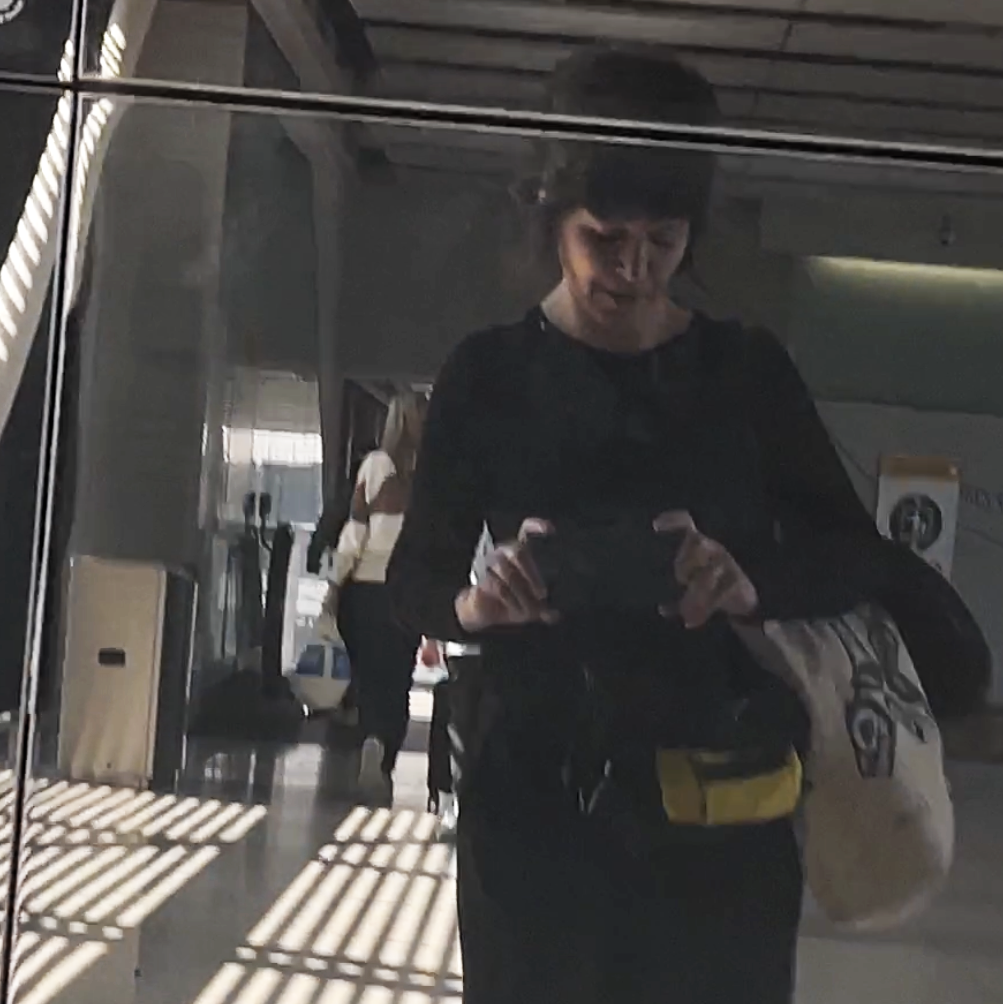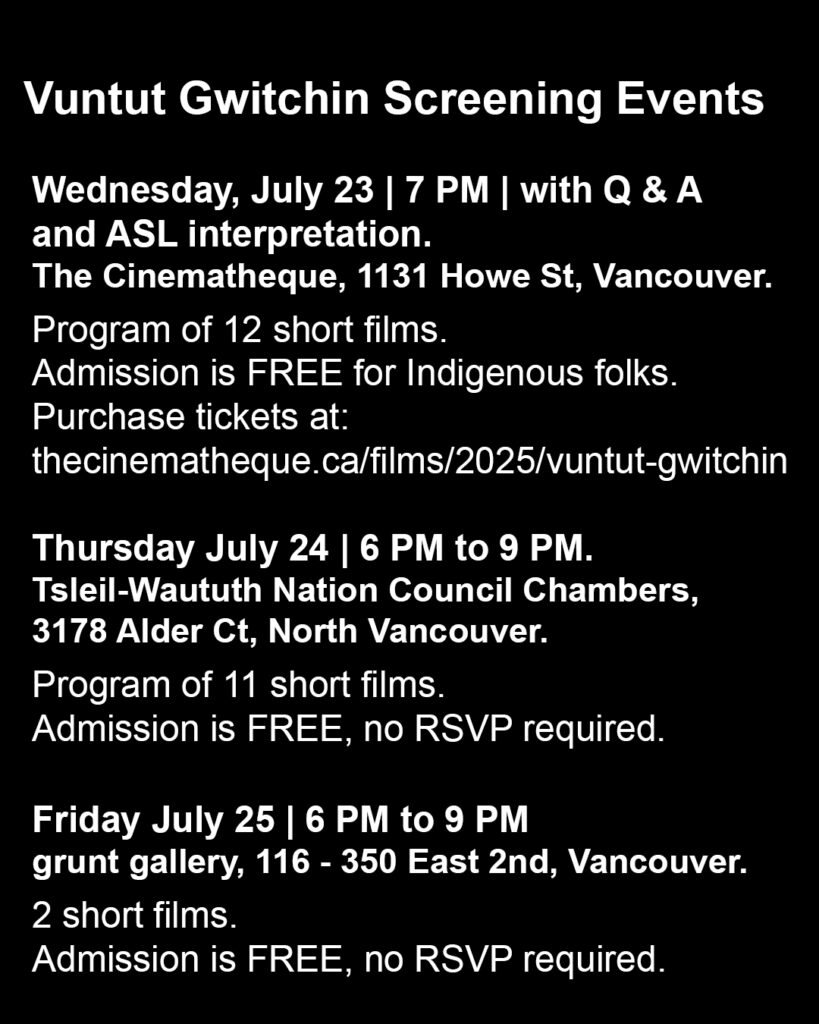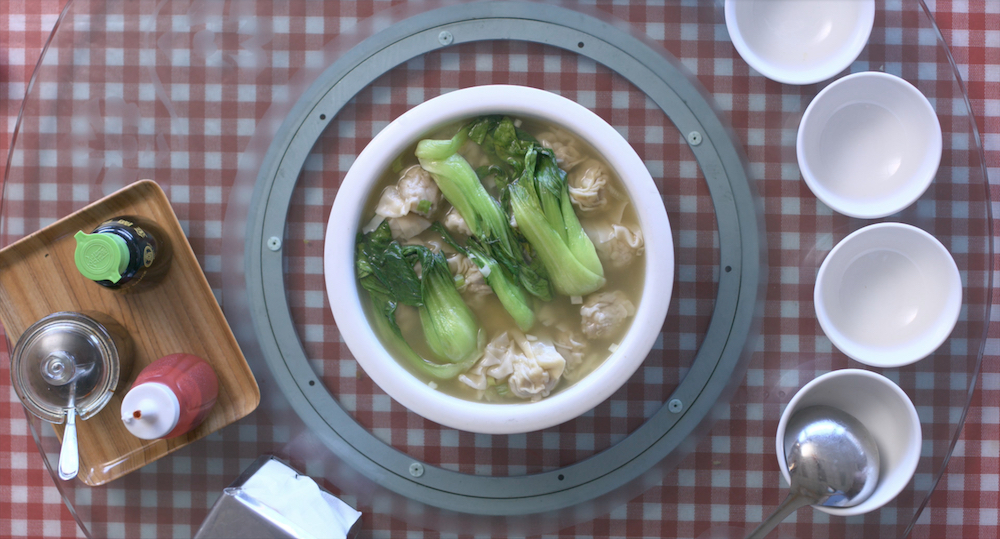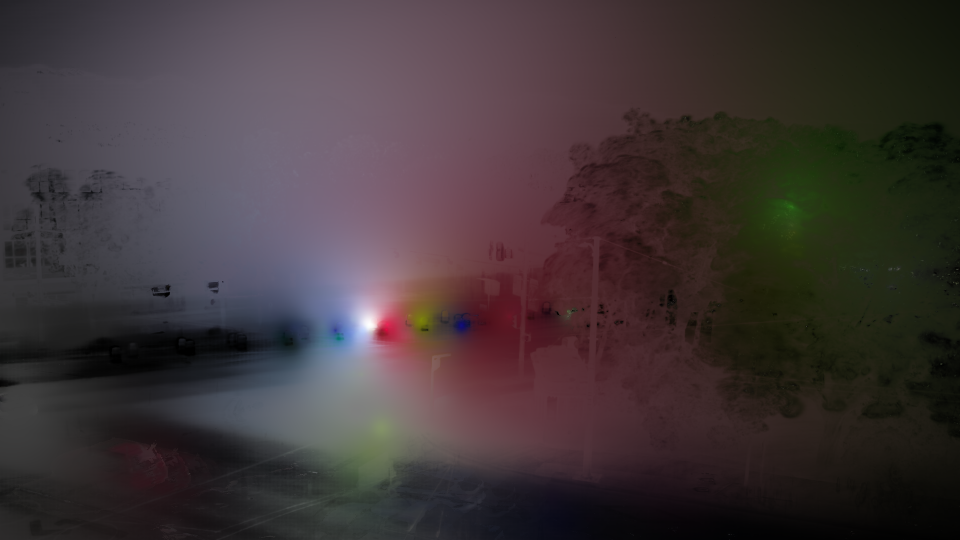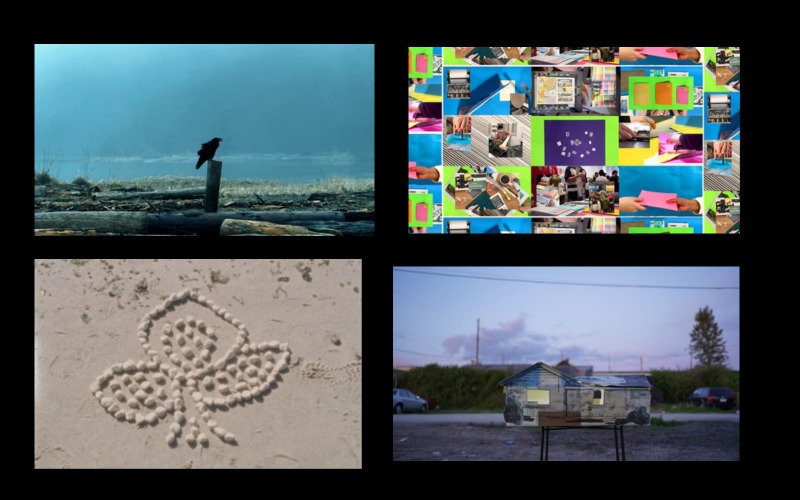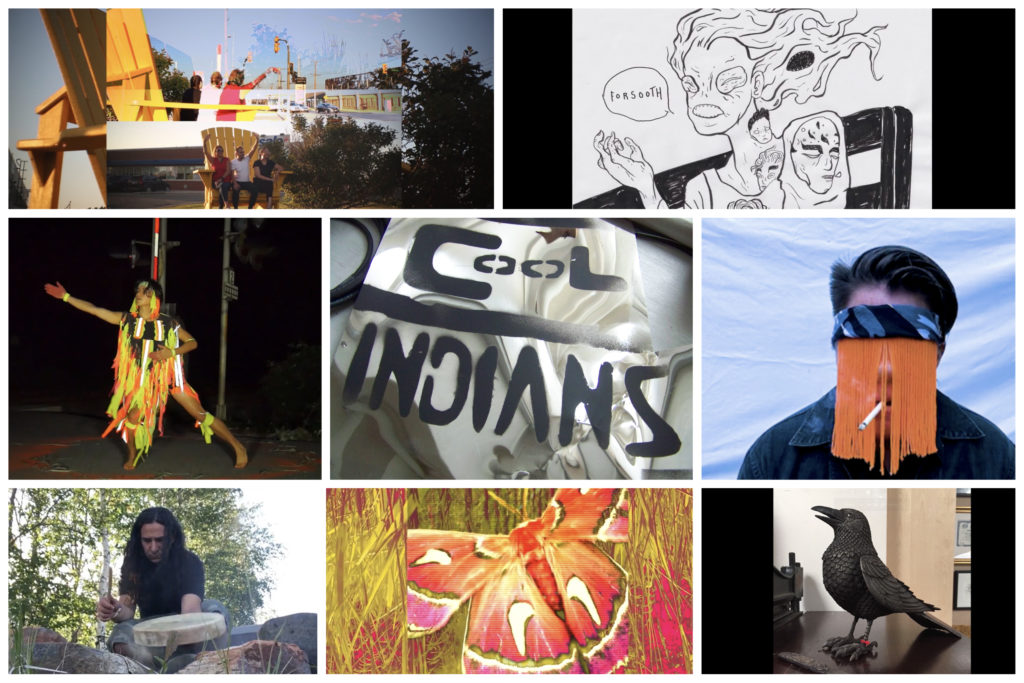Creative Access Audio Tour
Transcript note: The Indigenous nations are written in English to reflect that this tour prioritizes non-visual or Blind visitors who may be accessing the tour with a screen reader. We both respect ongoing language revitalization efforts and that updating assistive technology to allow for cultural respect and safety is slow and imperfect. Thank you for your patience.
Introduction
Welcome to grunt gallery’s creative access audio tour of there hidden, far beneath and long ago, the exhibition project by artist Moozhan Ahmadzadegan. My name is Kay Slater. I am a white, hard-of-hearing, queer settler on these stolen and unceded Coast Salish lands, the ancestral territories of the Hunquminum and Squamish Snichim speaking peoples. As the accessibility and exhibitions manager and preparator here at grunt, I assisted in installing this work. I have reviewed this script with both our artist and curator, but any pronunciation errors or cultural misrepresentations are on me. We welcome your feedback as we develop more creative access tools for our gallery and exhibitions.
This tour has four chapters. The fourth chapter is split into four parts, which allow you to jump back and forth through the exhibition descriptions when listening online or on the gallery’s audio players. The gallery transcript allows you to scrub the complete tour file using timestamps. At the start of each chapter, you will hear the sound of a page-turning:
[Page turning]
In Chapter One, I will detail the space and how to enter it and orient yourself in the gallery. In Chapter Two, I’ll describe our welcome station and the objects available for you to use and touch. Chapter Three covers our facilities, washrooms, and C-Care stations. If you’re ready to tour the show, you can skip to Chapter Four, where I will read the wall didactic and walk you through the show, but if you are skipping ahead, be aware that the welcome station has a tactile map to help you navigate this tour. Chapter four is broken up into parts as I move to different artworks in the show. When I move to a new artwork, you will hear this sound of chimes:
[Mystical chimes]
Let’s get started with Chapter One.
[Page turning]
Chapter 1: Physically Entering the Space
When approaching grunt gallery at 350 East Second Avenue from the accessible drop-off on Great Northern Way, follow the sidewalk to the building’s main entrance. Turn left at the entrance, and you’ll find us at the first exterior door, unit 116. A low-grade ramp leads to our front double doors, with automatic door buttons at waist and ankle level on a post to the right. Be cautious of the small lip at the threshold, which is a potential tripping hazard. Excluding Thursdays, masks are now optional and only recommended indoors at grunt; if you forgot yours, we have extras near the entrance and will not enforce their use outside of Thursdays for low-sensory and voice-off visiting hours.
Welcome to grunt gallery! We are situated on the occupied, stolen, and ancestral territory of the Hunquminum and Squamish Snichim speaking peoples, specifically the land of the Musqueam, Squamish, and Tsleil Waututh peoples and families. We are grateful to be here
The current show features painted works with ropes that dangle and lay on the floor on the left side, and a free-standing sculpture in the far left back corner. A tactile tape runs on the floor to mark any tripping hazards. If you require assistance and are not greeted by staff upon entry, please call for help. Staff are in the office and will assist you as soon as possible. We are always happy to walk the show with you.
The public gallery space is a white cube with 20-foot walls on three sides and a 12-foot south wall that opens 8 feet before reaching the ceiling, providing light to the loft office space beyond. The office is not visible from the gallery, except for a large convex mirror that allows staff to see visitors. A tone rings when people enter the space.
On low-sensory and voice-off Thursdays, a staff member will be available but will not greet you, allowing you to move at your own pace. If you are non-visual, call out for help anytime. If you are sighted, please silently approach a staff member. We have hard-of-hearing staff on site, so a visual wave may be required to get their attention.
[Page turning]
Chapter 2: grunt gallery’s welcome station
As you enter the gallery, immediately to the right on the west wall is a sanitization and welcome station. The station is white with black labels in English, high-contrast icons, and some braille. There are three open shelves, including the top surface, and the two shelves below can be pulled out towards you. Below that are two closed drawers with d-hook handles.
On top of the welcome station is our gallery spider plant, Comos, who is watered on Wednesdays. The top surface holds a leather-bound guestbook with a black pen, a bottle of hand sanitizer, and a box of masks with tongs. A digital tablet lets you browse the exhibition page on our grunt.ca website or access our Big Cartel eCommerce store.
On the first pull-out shelf, on the left, is the exhibition binder with large print information about the space, the show, the artist, a transcript of this tour, and the exhibition map. On the right are a series of tactile objects. Our tactile objects are creative access tools designed to create a point of entry for non-visual, Blind, or partially sighted guests who may wish to experience the work through touch or by bringing the objects close. However, tactile objects are also sensory objects that can be used by sighted folks who wish to feel a connection to the work and those who enjoy or are supported by having objects in their hands to touch.
Here, there is a large multimedia print here to touch. It uses acrylic and gouache paint as well as UV screen-printed images. This tactile object is associated with works that are hung on the wall and in the sculptural installation. The artist shared this print to present the textures used in the sculptures and illustrations. Two additional smaller tactile drawings isolate some of the patterns used.
Four additional sheets have tactile translation of the installed work on the east wall, depicting the patterns screen printed on the wall-mounted works, and repeated across the 2 panels.
These tactile objects are provided as a sensory point of entry into the works and are not necessarily representative of the work or equivalent to experiencing the works through explorative touch. We do not present these objects assuming that you have never had access to them, but we also do not assume that you have had these experiences. Smell them, hold them, observe them. Use them however you’d like as you engage with the show. This show, in particular, can be touched with a gentle hand, but these objects allow for a close examination and manipulation of details.
On the second pull-out shelf, to the left, are laminated maps of the space. Also within these shelves is a 3D map of the gallery and a flat 2D tactile map of the entire first floor space. Use the tactile maps to follow along with the creative access tour while in gallery. Works are indicated by unique shapes glued to the map with pauses and descriptions with braille markers A through F. You are currently at location A.
To the right of the maps are two Yoto audio players with large, friendly buttons. These players contain this tour and audio of any text within the binder. On the wall to the left of the welcome station is a scannable QR code or tappable NFC tag that links to this audio tour. On Thursdays, the Yoto players are moved to their carrying cases for use with headphones.
Below these are the two closed drawers. The first contains carrying cases with straps for headphones and the Yoto audio devices, allowing hands-free use.
The lowest drawer contains earmuffs for large and small bodies, specifically for those with noise sensitivities.
That concludes the description and tour of the welcome station. In the next chapter, I will tell you about our washrooms and c-care stations. If you prefer to continue with the exhibition tour, skip to Chapter Four.
[Page turning]
Chapter 3: The Facility and Amenities
If you need to use the washroom, it’s at the far end of our space. Exit the gallery through the doorway and follow the west wall (to your right when you enter). Pass by the media lab, and when you reach the back wall, take a left and walk through the small kitchenette to our single-room, gender-neutral washroom.
If you’re using the 2D tactile map, the washrooms are located at E.
An automated door button to the right holds the washroom door open for 14 seconds. Inside, to the left of the door, is the lock button, which creates a visual indicator that the washroom is in use. To exit, you can open the door manually or hover your hand over a button above the sink, below the mirror.
Near the exit button is a vertical cubby stack of supplies. Please help yourself to items like hair ties, disposable floss, sanitary napkins, and condoms. This is part of our C-Care program, Community Care for Artist-Run Events.
Speaking of C-Care, we have a tea station in our media lab.
If you’re using the 2D tactile map, the C-Care tea station is at location F.
A television is wall-mounted above the tea station. This is a Satellite Screen of our public and permanent Mount Pleasant Community Art Screen located at the corner of Kingway and Broadway. The screen is a community urban art screen in Mount Pleasant, and you can learn more at mpcas.ca The presentations are all silent video with captions for sighted engagement when either watching here or passing by in the noisy city landscape. If you would like any of these vignettes described, please call out to our staff.
Also here is a colouring station for people of all ages. Take a pause and a break here before returning to the gallery and continuing the tour.
We now arrive at Chapter Four, where I will begin the exhibition tour next to the welcome station, as if I had just entered the gallery, stepped right to sanitize my hands, and grabbed the tactile map.
[Page turning]
Chapter 4: The Exhibition Tour
4A. About the Show
Moozhan shares: “Queer culture and Iranian diasporic themes have been the focus of my practice for the last few years. I do not have specific inquiries, nor do I seek specific answers, but rather I attempt to create a point of access for both myself and the viewer. Playing with these themes has allowed me to deepen my connection to queer culture, my Iranian heritage, and myself. Working with these ideas has also presented opportunities for me to explore interdisciplinary approaches, strengthening my material and conceptual explorations while also embracing experimentation. I am excited by the interplay of materials and the discoveries I have been making in my practice.”
If you’re using the tactile map, we are at location A near the front of the gallery near the entrance.
On the wall behind and above the welcome station is wall didactic text in black vinyl that reads:
there hidden, far beneath and long ago
Moozhan Ahmadzadegan
Curated by Whess Harman
February 20 – April 5, 2025
The show’s title is in lowercase letters.
Within the exhibition binder at the welcome station is the exhibition abstract or artist statement and artist bio, as well as the timestamped transcript of this tour.
Within the space, its walls a neutral gallery white, are two works across 3 walls. The works are bright and colourful, and the shades are up, allowing for natural light to come in from the busy street outside. If you need assistance moving through the space or viewing any work, please feel free to call out for help while on-site or contact a staff member for assistance before arriving in the gallery.
Let us move through the show.
[ Mystical Chimes ]
4B. One thing is certain and the rest is lies – west
If you’re using the tactile map, we are moving from the welcome station (A) to location B, facing the west wall.
Following the west wall (left) from the welcome station about 2 metres or 6 feet away is a large, painted pine plywood panel has been installed about 2 feet or 60 cm up from the ground. In the middle and offset a little right is an arched window opening backlit with bright, sugar-drink pink LED lights. The lit cutout creates a soft, glowing halo on the wall behind it. It is playful and striking, 4 feet wide by 7 feet tall or 120 by 220 centimetres work, installed in the centre of an otherwise empty expanse of wall.
This work is part of the installation titled: One thing is certain and the rest is lies.
Moozhan shares: “This architectural shape derives from Persian miniature illustrations, where the scenes are painted with peculiar flatness. I use peculiar to describe them as sometimes they do not often make sense in terms of space, scale and perspective. High horizon lines, lack of vanishing point, and irregular scale contribute to this. With this artwork, I attempted to replicate the flatness of the source material.”
Our curator, Whess Harman, asked Moozhan, “Your work is non-figurative. Is there a particular way you think about that, in terms of referencing Persian miniature?”
Moozhan responded: “Yeah, I don’t. I want to invite viewers into a new world, and whatever that world is is up to them. I don’t want it to be too specific, because I want people to use their imagination and their own interpretation.”
Whess added: “Yeah, I think scaling up the work and making it more of a structural piece also kind of lends to that idea of entryways and entering new spaces.”
By queering these traditional Iranian aesthetics, Moozhan is reimagining Persian visual heritage through a contemporary lens. The radiant pink light, often associated with synthetic, modern materials, contrasts with the historical references embedded in the patterns. The cutout, illuminated yet empty, invites us to consider themes of absence, longing, and the spaces queer identities navigate within cultural histories.
The textures painted can also be experienced using the tactile objects at the welcome station. A light hand can touch this work, but it is installed on the wall by a cleat and not secured for extended tactile exploration.
This work, One thing is certain and the rest is lies, includes a few different pieces besides this large panel, including images that have been tacked onto the wall and a freestanding panel near the back wall.
Let’s continue exploring this work with the installation near the back wall of the gallery.
[ Mystical Chimes ]
4C. One thing is certain and the rest is lies – south
If you’re using the tactile map, we are moving from west wall (B) to location (C), near the back of the gallery to the left of the door to the media lab.
Following the west wall left toward the back (or south-west) corner of the gallery is a door that leads through and into our media lab. You’re welcome to continue through here, grab a tea or take a break. I’ll continue in the gallery and pivot left so I am facing the back, south wall. If you’re touching the west wall, there is a drop back to show you’re in the doorway and about to leave the gallery. Turn left and follow that wall until you feel paper and then step back, facing it. Once positioned about 2 metres or 6 feet back from that wall, and then stepping a few inches to my left, I am near the 2nd panel of the work in the installation titled One thing is certain and the rest is lies.
It is a freestanding piece that shares the similar tall, arched silhouette and bright colour palette of its wall-mounted counterpart. It is supported by two perpendicular triangular feet (like a cross or X) whose edges are coloured with a shocking neon pink along the edges, their faces left unpainted, showing the natural wood. The panel stands upright on the floor, allowing us to walk around it, the piece painted on both sides. Tactile floor tape marks the approach and perimeter of the piece, but it is also secure enough to be cane detectable, all sides firmly touching the ground.
This panel is not illuminated, but the colours and patterns are bright and command attention. It uses the same colours and patterns but in larger square, quilt-like patches.
Behind the sculpture on the south wall, a mural of printed, poster-sized images unfolds. Each 18 x 24” piece displays a distinct pattern, all sharing the same bright colours found in the two large panels nearby. Together, they transform the 12-foot wall into something like a warm, inviting quilt. Some of these patterns appear in the tactile objects at the welcome station, inviting touch and deeper engagement.
Whess, again asked Moozhan, “I was just wondering if there’s any significant meaning for each individual pattern or if it’s more like an exploration of using different patterns?”
Moozhan responds: “It’s both. So in a lot of these miniatures or Iranian art, very traditional art patterns are very big. In architecture, painting, and textiles, you see these patterns quite often. In the miniatures, specifically, there’s always all these different mixes of patterns – on different buildings, and clothing that the figures might be wearing. I love the mix of all the patterns, and I wanted to really explore that. And a lot of these patterns often have different meanings, but sometimes they are inspired by Islam. For example, where these repeating geometric patterns are ever-expanding and they represent that beauty and that closeness to God. For reference, I am not Muslim, nor is my family, but we come from an Islamic country, so there is a lot of cross-cultural influence there. Many of the floral patterns, again, represent gardens, and gardens were in another idea of closeness to God or closeness to beauty or otherworldly.”
For me—Kay, your narrator—someone who is white, queer, and has spent most of my life on the west coast, where nature is wrapped in the damp, deep greens of cedars and pines—these patterns evoke gardens unlike any I’ve known. Some designs feature interlocking vines; others display geometric shapes—triangles repeating across the surface. The varying colours suggest hidden blooms tucked among dense leaves, vibrant and unexpected.
There’s a brightness here that feels both festive and comforting. The colours transport me: I imagine a fragrant, spice-filled outdoor gathering, somewhere far from here yet somehow close—surrounded by loving friends with a taste for neon, warmth, and joy.
Whess asked Moozhan, “I think what’s really striking about a lot of your work is the deliberate use of quite fluorescent colours. It feels very alive and lively. Is that a part of it? How did you select colours?
Moozhan answered: “Typically, these patterns would be very colourful, but not quite as vibrant in terms of some of the very neon or artificial colours that are being used here, but this was an experiment for myself to use more colour. To be more playful, not just with the patterns and colours, but with size, scale and materials. But I just really wanted to be really bold and strong and maximalist and sort of be a bit too much for the viewer, in a way. You might stare at it for too long, and it might hurt your eyes, but I just really wanted to play with that boldness and that maximalist approach.”
Let’s turn left and face the east wall, left of where you entered at the front door of the gallery.
[ Mystical Chimes ]
4D. Persian Carpet Series
If you’re using the tactile map, we are turning from the south wall installation (C) to location (D), facing the east wall.
Pivoting left to face the east wall, I feel along the floor for the tactile tape that marks the edge of the other work installed in the gallery. The work titled Persian Carpet Series, is a three-panel series, with each piece mounted at varying heights. From each piece, six elongated carpet tassels are suspended. These thick, heavily braided cords extend from the bottom edge of each panel, draping toward the floor and sprawling outward in undulating, looping paths, each ending in a luscious and dense tassel. The cords overlap and rest in bunching serpentine lines. Tactile floor tape outlines the perimeter of the installation to enhance cane detection and mitigate tripping hazards, but the artist welcomes us to make gentle contact with the cords, encouraging a tactile exploration of their dense texture.
Each of the panels is slightly taller than wide, 20 x 24 inches. The triptych, 3 works in series, are all installed much higher than wall works are usually installed, but sighted visitors tend to stand closer to works installed at the typical 56” off the ground. With the ropes coiling on the ground, it requires people to stand back and it is more comfortable to take in the work that is installed above “eye level”, defined by conventional non-disabled, median European measurements.
I’ll start with a colour description, going from left to right or nearest the window on the north wall, and then over to the right near the freestanding installation.
Pink (left) Panel: Positioned closest to the gallery’s north side near the wall of the window, this panel is hung slightly lower than the others, about 62 inches or 90 centimetres above the ground. Under the Persian-inspired floral and geometric motifs is a gradient of colours that transitions from soft, light peachy tones at the top to rich royal magenta at the bottom. From its base, six braided cords—alternating between a deep and bright pink—cascade downward, gathering loosely on the floor. This panel stands apart from the others, with more space separating its neighbouring green print.
Green (middle) Panel: Installed highest among the three, this piece is adorned with blue-green Persian patterns on top of an intense lemon gradient that fades into a soft lime. Its cords alternate deep dark night blue and sunshine yellow strands, snaking across the floor in intertwining lines that echo the panel’s intricate visual patterns.
Purple/Pink (right) Panel: Mounted between the other two in height and located furthest to the right, approximately 48 inches or 120 centimetres away from the nearby freestanding panel installation, this work features a gradient of soft floral violet tones blending into soft bubblegum pinks. The cords extending from this work alternate between a deep summer flower purple and soft floral candy pinks, their coils on the floor forming subtle overlaps with the adjacent rope arrangements.
All three works have decorative surfaces on top of their colour gradients that mirror traditional Persian carpet motifs.
Moozhan says the following about these works: “I created a Persian carpet printed on paper again with very bold colours. Each has a gradient and each has a different colour. These screen prints are on paper, but they are mounted to a wooden cradle board, and each has six tassels coming down from the bottom, collecting on the floor and overlapping. The idea here was to create a Persian carpet that was not functional, that betrayed its original idea or the intention of the object. So mounting them on the walls, making the carpet itself very small and not with textiles, and then elongating the tassels to be 15 feet long… thereby, I have made this object no longer a functional carpet!
With no set meaning, these objects offer the potential for new narratives.”
[ Mystical Chimes ]
With that, we conclude the described tour of there hidden, far beneath and long ago. Later, during the exhibition’s run, we will have a curator’s essay and curatorial fellow commentary, as well as a response from author Asia Jong, available in the exhibition binder and digital assets.
Thank you so much for joining us on this creative access audio tour! We’d love to hear your thoughts on this experience and how we can improve it. If you carried any tactile object(s) during the tour, please return it to the welcome station! We acknowledge that we cannot be everything to everyone and respect that our creative access explorations may not serve your needs. You can reach us at access@grunt.ca or chat with any of the staff on-site with any feedback you have the capacity to provide.
Thank you again.
Curatorial Essay
by Whess Harman
We knew we wanted to put Moozhan’s show in the gallery for the spring. In the rain-drenched slide over from winter to spring and the city’s skies are low canopies of clouds sweeping across the glass and concrete, the idea of walking into the gallery to be greeted by vibrant colours and dizzying, intertwining patterns felt not warm and inviting so much as a welcome neon shock to break the mud and grey. It was the right choice; I’m not sure I’ve ever spoken to so many new visitors off the street who came in because they were so intrigued by the artwork that they couldn’t resist taking a closer look.
When Moozhan explains to me the different elements within the exhibition, it’s not lost on me that there is a practice of constructing a distinctly queer space out of this work despite the lack of overt references to queerness. There are no flags and no slogans, no representations of queer bodies; and yet, when I am standing within the space I feel a sense of being invited and held within the safety of the artwork because of the way Moozhan’s work blooms throughout the exhibition space. Though the patterns are fixed and largely non-figural, they feel lively in how they merge together recognizable traditions in Iranian art but are enacted with a hand-painted looseness. Pushing the colour scale towards neon bends the work towards an immediacy that agitates one into a state of excitement, a distinct difference from the coordinated calm of Persian gardens. These gentle subversions feel distinct to Moozhan’s sensibilities about his own identity and cultural heritage, a way to claim space that doesn’t require the force of a shout. I don’t mean to decry our battle cries; I enjoy the catharsis of shouting in the streets, but I also appreciate and believe in a diversity of approach. The queerness of this work moves slowly but insistently, there for those who recognize how it, we, are threaded through the places and communities we move through.
This work comes at a complicated time; the right-wing is off the deep end and the queer community itself is not unified in their support and recognition of trans and intersex identities especially. There is much to be said about this that goes beyond the purview of a curatorial introduction to the work, but to create a garden, to me, speaks towards our better impulses toward one another. These works feel like they were made not with the intention to instruct an outside audience but instead to exist as a reprieve for those who need it. The word “sanctuary” comes to mind, both in its definition as a refuge from persecution but also in its usage as a nature reserve. The creature in me craves these spaces where queerness can live accosted, unabated and not just tolerated but celebrated.
Most of the conversations I have with artists are interjected with the escalating dangers of authoritarian governments, that constant, consuming feeling of being caught between not doing enough while rapidly eating all the information we can to brace for what’s coming. What is the point of us artists and curators and what we do? Do we need the exhibition, the publication, the project? What do we offer in these moments?
We offer a diversity of strategies. We invite one another into our sanctuaries and gardens. We do the exhibition, the publication, the project, and we learn about one another while we do it–it’s easier to brace for the wave when you recognize and love the ones who are standing beside you.
Exhibition Essay
by writer, Asia Jong
I sit in the living room and see the construction crew in hi-vis vests gradually build the apartment across the street. Over the period of two years, what began as a hole in the ground has become a ten-story structure rising higher than any of the buildings surrounding it, including the top floor of my house. Like a desktop background, it gradually shifts, emerging one chunk at a time in the frame of my window. I didn’t know the building was going to exist when I moved to this neighborhood. But I watch as piece by piece, my supposed exterior turns into something much different from what it once was.
A block of grey and caramel aluminum siding fills the entire sightline from the second-floor window like a giant Quadratini wafer. The pattern of its crisscrossing facade and perfectly dispersed windows becomes a flattened plane of repeating lattice that seems to arrive within the living room itself. Insidiously, it slips through the glass, unfolding across the interior like new wallpaper. If all I knew was this view—one limited to the window’s frame—the structure could easily keep on going, repeating its pattern in endless tessellation. And for a moment, my negation of a perceptual understanding indulges its expansion. Linear tendrils weave in squared multiplication as it extends first over the curb, crossing the road past the neighbour’s lawn and then ascending above the skyline. It fills somewhere between here on this block and an undefinable expanse—ceaseless and never-ending.
For about the same duration as the construction of the building, an ornamental paper star lamp has been hanging from my window. The timing of its arrival into my home coincided with the beginning of the build. Despite its existence as seasonal winter decor, it has inexplicably stayed up throughout the years and adamantly resisted the monthly comments that “we should probably take that down.” I tend to forget about its existence until I return home in the evening—my pseudo-North Star. I can see the glow shining from the sidewalk and, on the other side, the towering building. To my relief, in the time I’ve left my house, it hasn’t yet subsumed the whole block. But just in case, I’ll keep that star up.
—
In the exhibition, there hidden, far beneath and long ago, architecture and objects struggle with their forms, yearning to give birth to something new. The works by Moozhan Ahmadzadegan draw from patterning and architectural elements from Persian miniature paintings and carpets, but here, the forms grapple with an existence not confined by tradition or shape. Vibrant hues of electric blues and lime greens contrast against gradients of pink, filling the room with motifs of flora, windmill blocks, triangular patchwork, and 12-pointed stars. The boldness radiates an ornamental elation that is playful in its vibrancy but also unyielding in its multiplicity—an undertone of defiance seeps through the paint. There is something insistent in the way the forms press forward, in the way they refuse containment as they replicate themselves onto the walls around them.
In the work Untitled (one thing is certain and the rest is lies) (2023), what was once a two-dimensional representation of three-dimensional architecture is now wrenched back into sculptural form—ripped from the page (or canvas) and stretched beyond its origins. This regurgitation seems to have carried a few indicators of its source. It maintains the traces of its architectural structure but shifts into a kaleidoscopic rhythm as repeated patterns emerge, overflowing without care for its container. There is a shameless process of reanimation. These are not just forms but gestures towards a place of mutated transformation, of queering what was once rigid, of unsettling the expectations placed upon history and its ornamentation.
At the same time, the works seem to express an agency of their own. As if they had gotten fed up with getting stepped on all the time, the carpets blatantly reject the notion of staying on the ground. In a state of mid-evolution, the carpets in Ahmadzadegan’s Carpet Series (2024) defy their purpose and triplicate as if they have undergone a type of mitosis, a division of their cellular structures. They begin their new life by climbing up the walls, leaving a trail of tassels behind them. Instead of falling into line with their predetermined existence, they find reinvention as wall hangings and obliterate their usefulness as floor mats altogether by actively working against their intended purpose. Here, they create elongated and enlarged tassels that tangle onto the floor like some sort of tripping hazard. The carpets are not just decorative objects to adorn the gallery or a home; they are interruptions, provocations that demand presence and seek disruption.
Caught somewhere between past and present, between surface and structure, between confinement and expansion, Ahmadzadegan’s work exists in a state of becoming. In this in-betweenness, custom is distorted and unravelled, desperate to create enough room to assert one’s own existence within a lineage of tradition. We have no control over the narratives we inherit or the structures that rise around us in a city driven by relentless development, but we can carve out space in the gaps—reshaping, resisting, and redefining the boundaries imposed upon us, however big or small that act might be.
